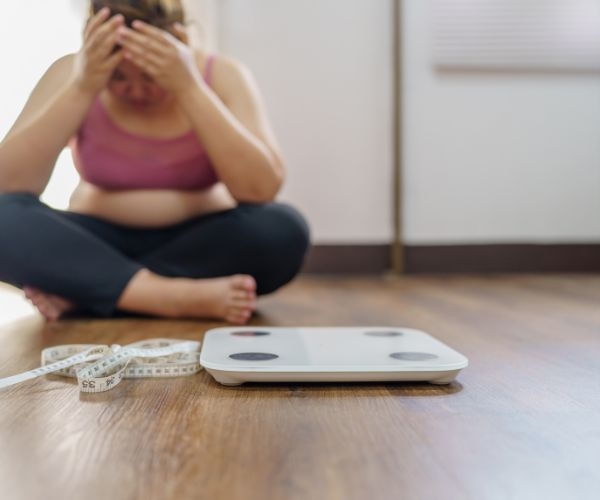How to Reduce Hormonal Belly Fat: Simple Strategies for Women
Take charge with how to reduce hormonal belly fat, tailored for women. Start using small, proven changes and feel stronger every day.
HEALTH & WELLNESS
Shari Smith
7/24/202510 min read
As an Amazon affiliate, we earn commissions at no extra cost to you if you click our links and make a purchase.


If you've been frustrated by stubborn belly fat that won't shift no matter how many crunches you do, you're not alone.
Hormonal belly fat can feel different from regular weight gain—it often shows up as deeper fat around your middle and can linger even when you make healthy changes.
For women, shifts in hormones like cortisol, insulin, and estrogen play a special part, sparking changes in your body and how you store fat.
Traditional diets and workouts might miss the mark if they don't consider those hormonal ups and downs.
That’s why learning how to reduce hormonal belly fat calls for a kinder, more focused approach.
When you understand the hormones behind the struggle, you start to discover new ways to support your body and nurture lasting change.
This post is meant to walk beside you and offer practical steps you can use—not just for a slimmer waistline, but for your whole well-being.
What Causes Hormonal Belly Fat?
When you look at stubborn belly fat that just won’t budge, hormones often hold the real key.
Stressful weeks, shifting cycles, and certain health conditions can work together and quietly tip the scales around your waistline.
Belly fat tied to hormones feels different because it grows from the inside out—your body’s own way of protecting you in times of change.


So let’s break down why this happens and what you can do about it.
Knowing what’s really at play can make the journey toward how to reduce hormonal belly fat much less confusing and a little kinder, too.
The Role of Cortisol: Stress and Belly Fat
When life gets stressful, your body turns to cortisol, the main stress hormone. Cortisol tells your body to hold on to energy for “just in case” moments. But when stress hangs around week after week, that extra energy hangs around your belly, too.
What does this look like day to day?
Long work hours
Late-night worries
Juggling family needs
Even skipping meals or limiting calories too much
Your body hears all of this as stress. You might start to notice cravings for sweet or salty snacks, or feel more tired than usual.
These are signs your cortisol is pushing your body toward storing fat in your belly. That’s not a sign of weakness or laziness—it’s pure biology.
But the good news is, small steps like breathing exercises or a short walk outside can help reset your stress response and make a real difference.
Estrogen Imbalance and Midsection Weight Gain
If you’re a woman in your 40s or 50s, you may notice your body changing shape even if your habits haven't changed.
Menopause and the years leading up to it (perimenopause) come with a rollercoaster of estrogen shifts.
Estrogen naturally drops during this time, which changes how you store fat—instead of the hips and thighs, it moves right to the waist.
Even younger women can feel the effects of estrogen swings. Birth control, PCOS, and hormonal cycles all play a role.
Common patterns you might see:
Waistbands getting tighter even if your weight stays the same
Mood swings paired with changes in your body size
A feeling that losing belly fat just got much harder
These aren’t personal failures. They’re hormonal signals, reminding you that your body is adapting.
By recognizing these shifts, you can start to make choices—like gentle movement or adjusting your diet—that help balance hormones while working toward how to reduce hormonal belly fat.
Insulin Resistance and Its Effect on Abdominal Fat
Insulin is like a traffic cop for blood sugar, helping energy from your food get into your cells.
When insulin stops working as well (called insulin resistance), more sugar stays in your blood and your body stores it as fat, mostly around your belly.
You might be at higher risk for insulin resistance if you:
Eat lots of processed or simple carbs, like white bread or sugary snacks
Skip physical activity
Have medical conditions like PCOS or a family link to diabetes
Insulin resistance can sneak up on you. You could feel hungry just an hour after eating, get tired easily, and notice thicker layers of fat around your waist even if the scale is not moving much.
The path to how to reduce hormonal belly fat here starts with small shifts: stable meals, less sugar, and any movement that fits your life.
Belly fat is never just about willpower—it’s a sign your hormones are whispering for help. Learning to listen to those signals is the first true step to change.
Lifestyle Changes to Reduce Hormonal Belly Fat
Shifting how you eat, move, and care for your mind may seem small, but these habits add up in life-changing ways.
You don’t need to overhaul everything overnight.
Quiet, steady changes can bring relief and help you feel more connected to your own body again.


If you feel worn down by stubborn belly fat and suspect hormones are involved, you’re not alone.
Here’s how to bring your daily routine in sync with your body’s needs and start seeing shifts where they matter most.
Prioritizing Nutrition: What to Eat and Avoid
Food is never just fuel—it’s information for your body. Choosing what goes on your plate can either turn down the stress hormones or send them spinning.
A few patterns make a big difference when working to reduce hormonal belly fat:
Fill your meals with anti-inflammatory foods. Think leafy greens, berries, fatty fish like salmon, walnuts, and colorful veggies. These foods calm quiet inflammation, which helps your body rebalance hormones and tap into belly fat for energy.
Cut back on added sugars. Sugar isn’t only in desserts—it hides in yogurts, cereals, sauces, and even bread. High sugar spikes insulin, which signals your body to store more fat around your waist. If reading labels feels overwhelming, start slow and swap sweet drinks for water or herbal tea.
Choose high-fiber, slow carbs. Foods like oats, beans, apples, and sweet potatoes take longer to break down. They help keep blood sugar steady, which supports healthy insulin levels and less fat storage.
Balance your macronutrients in each meal. Pair protein, like eggs or beans, with healthy fats (avocado, olive oil) and plenty of vegetables. This combo helps you feel full longer and avoids those energy crashes that drive cravings.
Be picky about processed foods and alcohol. Processed snacks and drinks can throw hormones for a loop. Try simple swaps—bake chicken at home instead of grabbing fried takeout, or sip sparkling water with fruit instead of wine when you want a treat.
Simple, patient nutrition shifts let your body know it’s safe—and that’s the first big step for lasting change.

The 7 Best Foods to Reduce Hormonal Belly Fat
Watch Video...
Stress Management Techniques to Balance Hormones
Stress isn’t just a feeling; it shapes your whole body from deep inside. High stress keeps cortisol humming, leading to more belly fat and less restful sleep. Soothing stress helps your hormones work with you, not against you.
Here are grounding habits to ease stress each day:
Practice mindfulness. Five minutes a day makes a difference. Notice your breathing, the weight of your body in your chair, or the sounds outside your window. Mindfulness signals to your body that the “alarm bells” can quiet down now.
Try simple yoga or stretching. Gentle movement opens up stiff muscles and brings in fresh energy. You don’t need fancy gear—just a mat or towel and a few minutes.
Prioritize sleep. Aim for a bedtime routine: dim lights, limit screens, and slip under the covers at a steady hour. Even thirty minutes more sleep at night can lower cortisol and help balance other hormones linked to belly fat.
Talk or write it out. Letting feelings land on paper or sharing them with a trusted friend does more than release tension—it reminds you that you’re not carrying the weight of change alone.
Step outside. Sunlight helps set your body clock and lifts your mood. Even a walk around the block softens anxiety and steadies hormones.
Small acts of care go far. Lean into what feels calming for you, and watch how your body responds with a little more ease.
Effective Exercise for Hormonal Fat Loss
The best movement is the one you’ll come back to, over and over. When hormones shift, your body thrives with a mix of steady effort and gentle challenge.
Try adding these science-backed workouts to your week:
Strength training. Lifting weights, doing bodyweight moves, or using resistance bands builds muscle, which speeds up your metabolism. More muscle means your body burns more calories—even when you’re not moving. Muscle also helps regulate blood sugar and can pull fat from your waist.
Interval cardio. High-intensity interval training, where you alternate bursts of activity with rest, helps drop insulin and burn belly fat fast. You don’t have to run sprints—walking quickly up a hill, dancing between chores, or a home HIIT video bring the same benefits.
Gentle movement like walking or swimming. These keep stress hormones in check and get your heart working without overwhelming your system. They also let your mind unwind, making movement feel like a sanctuary.
Mix it up. Your body likes variety. A blend of resistance workouts, brisk walks, and restorative yoga keeps both hormones and motivation in balance.
Every bit of effort counts. Listen to cues from your body—some days may call for strong, sweatier sessions, while others need a slow stroll or time on the mat.
The goal isn’t perfection; it’s finding steady, loving motion that supports you as you work on how to reduce hormonal belly fat.
Why the NordicTrack T Series Treadmill is a Game-Changer
When life gets busy or the weather doesn’t cooperate, having a treadmill at home like the NordicTrack T Series ensures you never miss your 45-minute walk.
This treadmill isn’t just about walking; it’s like having a personal walking coach in your living room.
When to Seek Medical Support
Sometimes healthy habits alone aren’t enough to shift stubborn hormonal belly fat.
It’s easy to feel like you should just “try harder,” but your body might be sending signals that need a little extra attention.
If you notice symptoms that don’t budge or you feel something is off, reaching out to a healthcare provider could help you move forward with peace of mind.


Paying attention to what your body tells you is not about weakness—it’s a real act of self-respect.
Recognizing Symptoms of Underlying Hormonal Conditions
Not all belly fat is caused by lifestyle. Certain symptoms show up as quiet hints that hormones may be out of balance, and ignoring them can make things harder in the long run.
When you’re sorting out how to reduce hormonal belly fat, looking for these red flags can save you from guessing or self-blame.
Watch for these signs that may point to a deeper hormonal issue:
Persistent fatigue that doesn’t lift with rest or better sleep habits
Sudden or unexplained weight gain, especially around your belly
Hair loss or thinning, not linked to seasonal changes or new products
Missed, irregular, or very heavy periods
Acne or skin changes well past your teenage years
Unusual facial hair growth or dark patches on skin
Hot flashes or night sweats outside of expected midlife changes
Deep mood changes—like anxiety, depression, or brain fog
If you notice several of these popping up together, or if your everyday efforts stop making a dent, it’s time to check in with a professional.
Your provider may suggest hormone testing, which often includes simple blood work for estrogen, progesterone, testosterone, insulin, thyroid hormones, or even cortisol.
Sometimes a pelvic ultrasound or other checks help give a full picture.
These steps are about understanding your unique story, not labeling or shaming.
Medical Interventions and Hormone Therapy Options
When tests show your hormones aren't quite in sync, doctors offer targeted options to support your health and help you tackle how to reduce hormonal belly fat in a new way.
There’s no shame in getting some extra help—just as you’d fix a leak in your roof, you can shore up your body’s foundation with science-backed care.
Common treatments your provider may discuss include:
Hormone replacement therapy (HRT): Used for women with significant menopause symptoms or very low hormone levels. HRT replaces missing estrogen and balances other hormones, which can ease hot flashes, mood changes, and even help reduce stubborn belly fat tied to menopause.
Medications for conditions like PCOS: If you have polycystic ovary syndrome (PCOS) or irregular cycles, medications such as birth control pills, metformin, or anti-androgens may help steady your hormones. These options often help the body become less insulin-resistant and ease weight gain in the belly.
Thyroid medications: If low thyroid is slowing your metabolism and causing weight gain, thyroid hormone pills often bring relief and restore healthy fat distribution.
Insulin sensitizers: In some cases, drugs like metformin can help manage insulin resistance, making it easier for your body to lower blood sugar and stop storing so much fat in your middle.
Other supportive medicines: Depending on your symptoms, your doctor may suggest treatments for sleep, mood, or skin changes that come with hormone shifts.
Working with a trusted provider gives you a plan that fits your needs. Often, medical care is combined with changes in food and daily habits for the best results.
The path to feeling better isn’t always quick, but it is possible. Listen to your body, trust what you see and feel, and know you don’t have to walk this part alone.
Conclusion
You have the power to rewrite your story with how to reduce hormonal belly fat.
Real change grows from small, caring choices you repeat each day—gentle food swaps, patient movement, and learning to rest when your body whispers for it.
When you pair these simple habits with a willingness to seek help if your symptoms persist, you build a stronger sense of trust in your own body.
You’re not just shrinking a waistband. You’re nourishing your well-being and showing yourself real kindness. It takes persistence, and sometimes the progress feels slow.
But every small step adds up over time. Keep listening, stay curious, and remember that your effort matters.








